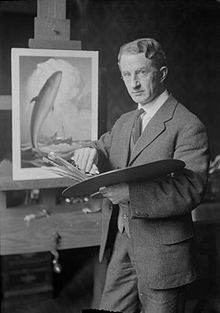Arthur Heming
Arthur Henry Howard Heming | |
|---|---|
 Arthur Heming, 1912 | |
| Born | January 17, 1870 |
| Died | October 30, 1940(aged 70) |
Arthur Henry Howard Heming(January 17, 1870 – October 30, 1940) was a Canadian painter and novelist known as the "chronicler of the North" for his paintings, sketches, essays and books about Canada's North.
Career as an artist
[edit]Born inParis,Ontario and raised inHamilton,he studied at the Hamilton Art School, then inNew York Cityat theArt Students LeaguewithFrank DuMond,and theOld Lyme Art Colony,and inLondonwith the Welsh masterFrank Brangwyn.[1]
Heming painted paintings depicting the fur trade, many for the bookThe Drama of the Forests.He asked theHudson's Bay Companyto include his work in their collection as a contributor to the history of Canadian wilderness exploration. Instead, in 1921, theRoyal Ontario Museumpurchased a selection of these paintings.Maclean'sMagazine then reproduced them for their covers throughout the early 1920's.[2]
A 124-page exhibition catalogue was produced byMuseum Londonin 2013, with five essays,Arthur Heming: Chronicler of the North.It followed a 2012 galleryretrospectiveof his work, shown at Museum London.
Heming was an associate member of theRoyal Canadian Academy of Arts.[3][1]
Difficulties as an artist
[edit]Heming was diagnosed ascolour blindand as a result worked mostly in black and white for almost all of his life, with the addition of yellow.[4]However, near the end of his career, he started to paint using the full range of colours, having been told by a fellow artist he was no longer colour blind.[5][1]
Novels
[edit]His highly popular novels were only three in number, but they enjoyed great success in serial form and then in fine book editions from major publishers. His novels were not armchair concoctions, as Heming had travelled extensively in the wilderness...
- "Among his northern journeys; he accompanied noted gentleman adventurerCaspar Whitneyto theBarrengrounds,patrolled with theRoyal North West Mounted Policein the mountains, and altogether travelled 550 miles by raft, 1000 miles by dog team, 1700 miles by snowshoe and 3300 miles by canoe. "[6]

Bibliography
[edit]- Across the Sub-Arctics of Canada(1898) (James Williams Tyrrell,illustrated by Heming who was on the expedition).
- Mooswa & Others of the Boundaries(1900) By William Alexander Fraser. Illustrated by Heming. New York: Scribner's, 1900.
- The Drama of the Forests: romance and adventure(1921, novel).
- Spirit Lake(1923, novel).
- The Heming Paintings of Northern Life(1923, limited edition artbook).
- The Living Forest(1925, novel).
Heming also illustrated books by other authors, especially those of the authorWilliam Alexander Fraser(1859-1933, not to be confused with the Canadian politician of the same name).
Biographical works include:Miss Florence and the Artists of Old Lyme(1971, local history); andArthur Heming: Chronicler of the North(2013, Museum London exhibition catalogue).
Family history
[edit]
The Hemings emigrated from Bognor (Regis) England in the top half of the 19th century. Edward Francis Heming left Bognor and settled just outsideGuelph, Ontario.on the Eramosa Line in 1832. He called the farm 'Bognor Lodge' and it is still there today in Heming ownership. The northern half of the farm was expropriated and flooded to makeGuelph Lake.
The Heming family traces its ancestors back toKing Harold Heming of Denmark,the lastVikingking of Denmark, and the one who brought Christianity to Denmark. They eventually travelled through France and settled there having the town named 'Heming' after them. When France became Roman Catholic, they were/are Protestants, they emigrated again just across the English Channel to the seaside spa of Bognor.
Edward Heming had five sons in Canada West. One of them was Charles Heming and he became the postmaster of the small village of Sydenham. Because there was another growing town near Ottawa with the same name, Charles was asked to change the name of Sydenham. He changed it to 'Bognor' and it is there today - a tribute to the pioneering Canadian Heming family.
References
[edit]- ^abcA Dictionary of Canadian Artists, volumes 1-8 by Colin S. MacDonald, and volume 9 (online only), by Anne Newlands and Judith Parker National Gallery of Canada / Musée des beaux-arts du Canada
- ^"Works".cowleyabbott.ca.Cowley Abbott Auction, Session 1 Important Canadian & International Art December 6th, 2023.Retrieved27 October2023.
- ^"Members since 1880".Royal Canadian Academy of Arts. Archived fromthe originalon 26 May 2011.Retrieved11 September2013.
- ^"Arthur Heming".Florencegriswoldmuseum.org. 1940-10-30. Archived fromthe originalon 2012-06-13.Retrieved2012-07-27.
- ^"Tribal Life in Old Lyme: Canada's Colorblind Chronicler and his Connecticut Exile".The Public Domain Review.Retrieved29 March2018.
- ^Michael Peake, "The Art of Heming", article at the canoe hub canoe.ca website.
